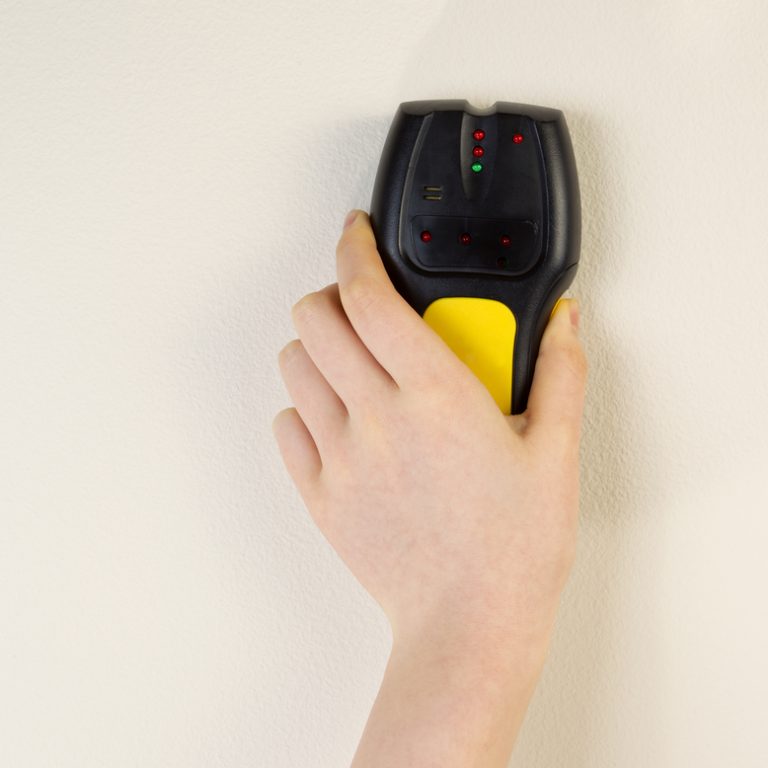The best stud finder can be used in construction or renovation work. As its name suggests, the tool is useful to detect metals and non-ferrous metal behind a wall. These metals can include regular water pipes, live AC wires, rebar metals or even non-ferrous metals such as copper pipes, used for central heating water circulation.
There are two main technologies used in these tools. They detect these metals and non-metals using magnetic or electronic methods. Of course, powerful magnets inside some stud finders make the job easy and quick. An electronic stud finder can be a precise tool. Based on changes in dielectric constant, the stud finder can indicate the presence of a stud. When the readings change to a lower frequency, it is a sign that a stud has been detected.
- Features to consider in Good Stud Finders
- Top 10 Best Stud Finders 2023
- 1. Imoocare Stud Finder
- 2. Drtulz Stud Finder
- 3. Anbes Stud Finder
- 4. Zircon MultiScanner 740 Electronic Wall Scanner
- 5. Tavool Stud Finder
- 6. Vivreal Stud Finder
- 7. Franklin Sensors FS710PROProSensor 710+ Professional Stud Finder
- 8. DeWalt 3/4 in. Stud Finder
- 9. Iyesku Stud Finder
- 10. Aikotoo Magnetic Stud Finder
- FAQ
- Guide to Buying the Best Stud Finder
- Conclusion
Features to consider in Good Stud Finders
There are multiple stud finders on the market. It is why those new to the field might even have a hard time deciding on which product to purchase. Regardless if the stud finder is used by a professional or simply used at home, it should be able to offer reliable results.
Multi-detection
Having the ability to detect metals and wires is a must. But the best stud finders can even detect wood studs. All of these capabilities actually come with considerable savings when it compared to tearing down walls to find studs.
Sensor accuracy
The accuracy of the sensor’s readings is different from product to product. Of course, the best accuracy is when the studs are not too deep inside the wall. This is why most products measure the right distance in millimeters. Under normal circumstances, wood studs are not as easy to detect further inside the wall as metal studs.
LCD display
An LCD display is the quickest way a stud finder can signal a stud. Having intensity readings on electronic stud finders can help pinpoint the exact center point of the stud on the LCD screen. The following stud finders use various extra features for accurate results.
Top 10 Best Stud Finders 2023
1. Imoocare Stud Finder
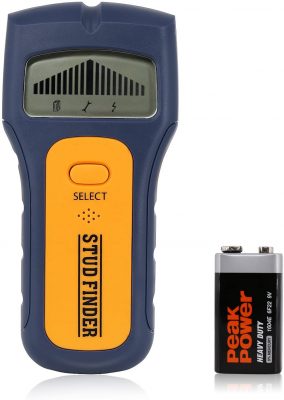
Editor’s Rating:
Design features
The simple design of the stud finder might see the affordable tool being an option even for professionals. One of the characteristics of the best stud finders is the fact that they need to be made with durability in mind as they can be used in harsh conditions. Imoocare’s stud finder is equipped with all that’s needed to quickly find various studs.
An LCD display dominates the upper half of the stud finder. Luckily, the readings are quite large and easy to interpret. There is a bar chart which has a center bar as guidance for the strongest stud signal. A few indicators are also present on the screen. They represent scanning functions for wooden studs or for live wire studs. A metal studs icon is also present on the screen to indicate metal studs.
With a test button and a selector button, the stud finder is also easy to set. Powered by regular 9V batteries, the stud finder can work for hours and hours. One of the advantages of its compact size comes with a smaller LCD screen as a result. This means the battery drain is considerably reduced to what is seen on some of the larger stud finders.
Convenient features
The multifunctional nature of the stud finder is what truly recommends it for every situation. It comes to show that even a compact design can be versatile. It works with rebar, steel, copper pipes, live wiring, and wood. This means that it covers most types of studs.
Its specifics are among the best as well. Wooden studs can be detected at depths of up to 19mm. Metal studs can be detected at depths of up to 30mm. Wiring can be detected at depths of up to 2”.
Even with its multi-capacity detection, it can still work powered by a single battery for up to a year. The good news is that even if it is made from plastic, it is also quite durable. It actually uses ABS plastic which is known for its durability. The same type of plastic is used in game console controllers as proof that it can last well in time. There are not too many drawbacks to the stud finder. Most users find it is made with good precision.
Verdict
As one of the truly mature stud finders, Imoocare’s product seems to offer everything that’s needed to find various studs.
Pros
- Works with wood studs
- Finds metal and wires
- Detects copper studs
- Compact practical design
Cons
- Minimalistic display
2. Drtulz Stud Finder
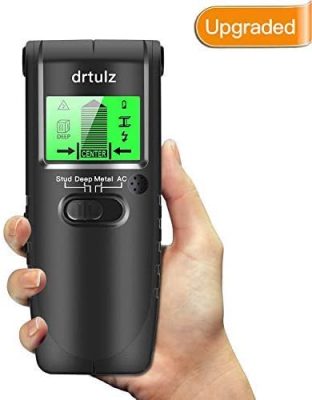
Editor’s Rating:
Design features
The handheld device is one of the choices construction workers have when dealing with existing buildings. Instead of endangering themselves drilling holes in the wrong place, they can use the Drtulz Stud Finder.
The design of the device allows it to be considered as modern, even in a category which doesn’t need too much innovation at this point. Dominated by a backlit LCD screen, the device can also be used in low light conditions. The readings are very simple on the screen and they use a bar system to indicate whenever a stud is found. At the same time, there is an audio beep which alerts the user of the existence of a stud.
A single button allows the user to select the type of stud to scan for. From metal to AC wires, it can detect all studs. The stud finder is powered by a regular 9V battery. There is a battery indicator on the screen as well, but users should only replace it after months of use. Other indicators on the screen include a metal mode indicator, an AC mode indicator, and a stud center indicator.
Using the stud finder is not too complicated. Users simply need to select the type of studs to scan and then press and hold the power button. With horizontal movements, they can scan across the surface they want to find the studs in. The stud finder also comes with an auto-off function. Turning the tool off is not necessarily user-based as a result. After 60 seconds of inactivity, the stud finder powers off to protect battery life.
The multifunction stud finder is made from ABS plastic. This type of plastic is durable and reliable. Apart from the models which come with extra rubber, it is considered to be made to a high standard of durability. It also comes with a weight of just above 100g. This means that those into construction can use it multiple times per day with no fatigue.
Convenient features
In terms of performance, the stud finder is as versatile as users can hope for. Metals and wood can be scanned at depths of up to 19mm and sometimes even up to 38mm. A special deep mode is also available which allows users to detect metals up to 60mm deep.
Using the bar indicator on the screen, users can also have a better understanding of the edges and the center point of the stud. This is where they have the freedom to scan around and to indicate the center point of the stud which is also accompanied by a beep.
Unlike many similar products, the stud finder also comes with auto calibration. Calibration is done by scanning a plain wall with no nails or no studs.
Verdict
Based on its auto calibration and modern display, the stud finder is one of the few options which come with a short learning curve.
Pros
- A large backlit LCD screen
- Beeps at the center of a stud
- Comes with a deep scan function
- Made with auto calibration
- Long-lasting battery included
Cons
- Inconsistent results with wood studs on deep scan
3. Anbes Stud Finder
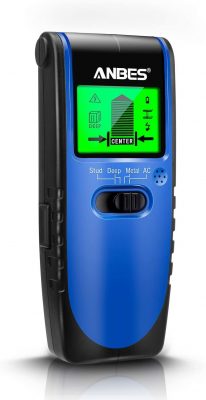
Editor’s Rating:
Design features
From a visual stud representation to an actionable design with just a few buttons, the tool manages to base itself as a simple alternative. There is a simple bar indicator showing the edges and the center point of the stud. However, one of the main advantages of the stud finder comes with its rubberized case. This means that it can be a tool to consider for busy professionals who need the improve grip for constant readings.
Apart from an anti-slip design, the stud finder features a backlit LCD screen. All the information relevant to the user is displayed here. From battery life information to the type of scanning mode, the screen is where users need to look at to get the latest on the readings. There is a speaker underneath the screen. Its role is to emit beeps whenever a center point of a stud has been detected.
The screen is among the best in its class. This is not necessarily due to its graphics but rather due to the displayed information. It shows all detection modes, automatic calibration information, signal strength information as well as battery information. Auto calibration is even easier to go through than actual scanning. It only requires scanning a wall free of nails or other distractions. Of course, calibration should never be made over freshly-painted areas. When calibration, users should also not place the stud finder directly next to a stud. The good news is that when the calibration is not done right, there is a flashing sign appearing in the middle of the screen.
Convenient features
The stud finder is very useful in construction, decoration or even furniture installation. Drilling positions need to be safe and free from studs. Drilling positions also need to be free of wires for safety reasons.
The stud scanner does a good job with wooden studs up to 19mm. A deep mode is also available but the results might not be as quick up to 38mm. AC scan and metal scan can go even further up to 60mm. With a weight of 146 grams, the stud finder is not the lightest option on the market. However, the extra weight comes from the rubberized ABS case. Some users even prefer a heavier stud finder for a more professional feel.
Verdict
Made to resist light shocks with its rubber casing, the stud finder is mainly made for heavy use.
Pros
- Extra rubber protection
- Comes with automatic calibration
- Signal strength bar on LCD
- Made to save energy
Cons
- No marking tool
4. Zircon MultiScanner 740 Electronic Wall Scanner
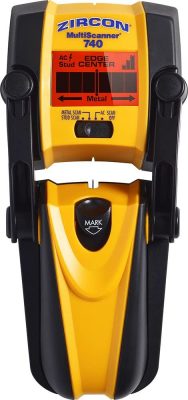
Editor’s Rating:
Design features
With decades of manufacturing experience, Zircon has managed to create one of the most robust wall scanners on the market. But there is more to its rugged design than meets the eye. It is one of the few stud finders which come with an included marking tool. The marking tool has its own button. Users need to push down the button in order to release the marking tool.
Another important physical feature comes with a bright display. It is one of the brightest in its class. While this may not be a concern for many users, others prefer such displays, especially when working on hallways or any other areas with low visibility.
Although the product comes with easy operation, some users might still need extra information on the stud finder. It is why Zircon offers good customer support as well. They can also point out the best ways to use the tool for accurate readings.
Convenient features
There are 4 convenient modes to switch between by the user. There is a unique floating head design on the stud finder. It has been made this way to improve accuracy, especially over uneven surfaces such as brick walls.
Most detected studs can be metals. But the stud finder also finds non-metal studs such as copper. Readings are accurate and they can also detect rebar. Furthermore, the powerful scanner also works through plaster.
Its StudScan mode works with scans of up to 19mm. In fact, this is its most popular model. It is why the manufacturer recommends the first scans to be made in this mode. Its DeepScan mode works with greater depths of up to 38mm. Of course, readings at this depth are not as constant. It is why the stud finder also comes with a warning light whenever a wire has been detected.
A dedicated Metal Scan Mode is also available. As its name suggests, it is programmed to scan metals. It works with copper scans within ½ in depth and with metal scans at a depth of up to 3 inches. This mode is particularly useful to tell if the stud is made from metal or if it’s made from wood. Wiring can also be detected using the scanner. All wires at a depth of up to 2 inches can be detected simply by choosing the AC Scan Mode.
Verdict
With dedicated scanning modes, users can consider the stud finder to differentiate wood studs from metal studs.
Pros
- Made with a bright LCD screen
- Designed with a floating head
- Detects AC wires up to 51mm
- Comes with an auto-correction feature
Cons
- Reduce accuracy over some gypsum walls
5. Tavool Stud Finder
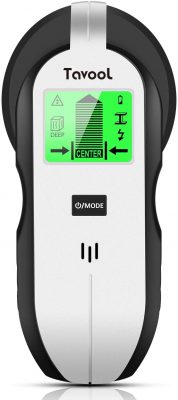
Editor’s Rating:
Design features
With an ergonomic grip, the stud finder comes with its own visual identity. It is easy to hold with a single hand and it comes with low weight as well. The ergonomic grip might not be enough to convince new buyers, but there is a lot more to it than its simple glass-shaped body.
Made with a rubberized grip, the stud finder is surely not slipping away from the hands. It is a solution which can even save money with possible future repairs. At the same time, it also saves money with the possible damage from drilling done in the wrong place.
There is a backlit monitor on the upper half of the stud finder. All the information displayed here is a result of the user input through the side buttons or a result of scanning and auto calibration. The power button on the left side needs to be pressed in order to power on the screen. A target indicator bar is immediately visible in the middle of the screen. The bar is similar to what is seen in most stud finders and it indicates the edges and the center point of various studs. There is a front speaker as well. As expected, it is this speaker which beeps whenever a stud is discovered.
Convenient features
With the standard 4 scanning modes, the stud finder detects most studs. Wooden beams and studs are detected at a depth of up to 1.2 inches. Metal and AC wires can be detected at a depth of up to 1.57 inches. A deep mode is available as well with results up to 1.77 inches deep. 85 to 240 V current can be detected at depths of up to 1.77 inches.
The good news is that all of these modes are used in the same simple way. First of all, a 9V battery needs to be placed in the stud finder. For the best results, the product also needs to be calibrated. This is done by placing it against a wall while holding the power button for up to 2 seconds. Detecting a stud is similar as well. Holding the power button, users can simply move the scanner along the wall until a beeping sound signal the existence of a stud.
Verdict
With a rubberized ergonomic grip, the stud finder scans all studs and its leading performance is seen with deeper AC current wires.
Pros
- Made with an ergonomic grip
- Comes with 4 scanning modes
- Built-in speaker for stud beeping
- Detects electrical wires up to 2.36 inches
Cons
- Batteries not included
6. Vivreal Stud Finder
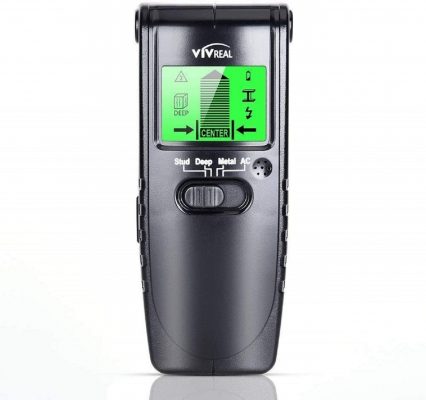
Editor’s Rating:
Design features
With an attractive compact design, the Vivreal Stud Finder is easy to hold. It does not have a unique or memorable look but its aim is utilitarian and it is here that it does its job well. A single button for mode selection means there is no time wasted on the construction site looking for complicated settings. At the same time, the backlit LCD screen means that all the stud reading information is easy to read.
There are only two buttons for the user on the stud finder. One is made for the power mode and the other is made for the scanning modes. Both are used with every scan. While the power button is held in place when making readings, the scan mode button only changed position before an actual scan.
There are a few debatable design drawbacks to consider as well. One of them is the simple plastic casing which might not survive a fall from a higher point. Another possible issue comes with the fact that it doesn’t have a marking tool included. So whenever a stud is discovered, users simply need to ensure they actually have a pencil to mark its spot.
Convenient features
The 4-in-1 design means no other tools are needed for stud detection. It means that construction workers or simple residents can use it with precision to detect the location of a stud and a point where drilling is excluded.
Automatic calibration is needed whenever the tool is turned on. As with most stud finder, the calibration is actually easy to achieve. Most importantly, users also need to know that its calibration also plays a role in accuracy. With all the features needed to detect metals, non-metals, wood, and current wires, the stud finder is reliable in most situations.
Verdict
Based on accurate results up to 51mm, the stud finder can be a solution for professionals or homeowners.
Pros
- Operated with just two buttons
- Comes with different scanning modes
- Emits a sound warning when a stud is detected
- A high contrast LCD screen
Cons
- Scanning the same edge can cause different readings at times
7. Franklin Sensors FS710PROProSensor 710+ Professional Stud Finder
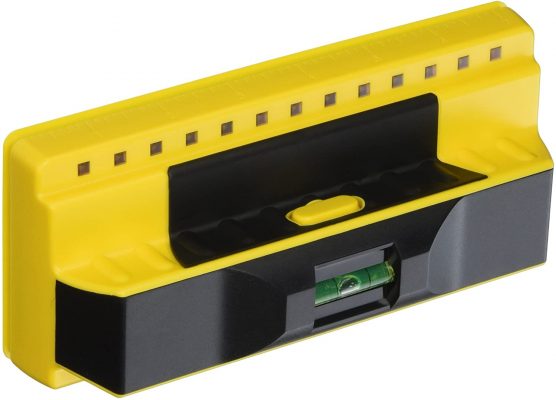
Editor’s Rating:
Design features
Franklin Sensors’ stud finder is actually one of the few distinct products in its class. It comes with a built-in bubble level and a ruler. It can certainly be useful when mounting furniture or even during general home decoration.
The product is easy to use and it comes with a unique design. While it is not ergonomic, its reduced weight means that it can even be used in different scenarios. Unfortunately, it may only work with flat or nearly flat surfaces due to its design.
Convenient features
Using the stud finder is where users will detect its unique approach. With 13 built-in sensors, it can cover most interior walls. Its detection range is among the best at 1.1in and similarly to what other stud finders offer at 1.6in.
It is also the only stud finder to use 2 AA batteries instead of the popular 9V batteries used in other products. But the batteries don’t make it as special as its no-calibration approach. Even when just turned on, the stud finder needs no calibration. Another unique feature based on its multiple sensors comes with its integrated stud finder readings. Simultaneous objects can be detected. At the same time, it detects the studs’ edges and center point directly at the same time. This feature is not offered on any other stud finder. It is why its quick scan approach is truly made for construction professionals.
Verdict
With a unique design and simultaneous readings based on multiple sensors, the stud finder is reliable for quick use.
Pros
- Offers simultaneous readings
- Based on 13 sensors
- Uses 2 AA batteries
- Included bubble level
Cons
- Not best on uneven surfaces
8. DeWalt 3/4 in. Stud Finder
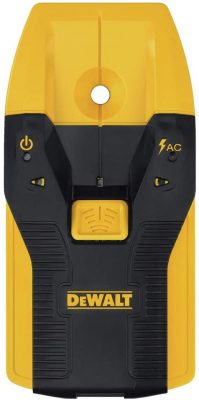
Editor’s Rating:
Design features
As one of the thinnest stud finders, DeWalt’s design is truly recommended for travel. It is easy to squeeze in any tool bag. With a low weight, it is also a versatile tool which can be used on small scales inside homes or on large scale on construction sites.
Of course, to achieve such a thin profile, the manufacturer had to let go of the LCD screen. This means that all the readings are based on audible alerts. For some users, this is seen as a loss. Others love the fact it allows the stud finder to be slimmer and for its battery to last longer.
There is a single power button on the stud finder. LED light signal scan modes which include wood, metal and AC wires. While the stud finder comes with no marking tool, it does come with a center point hole which can be where users mark the stud with the help of a pencil.
Convenient features
Powered by AAA batteries, the compact stud finder is easy to use. It has a detection range of ¾ inches for wood and metal. AC and other live wires are detected as well. Practically, the only feature it might be missing compared to leading designs is a digital display.
At the same time, it comes with advanced features such as auto calibration. This automatic calibration is actually made to save time and it is constant without user input. However, the stud finder can struggle in a few situations. With its flat profile, it may need multiple readings on uneven surfaces. At the same time, the lack of clear understanding of the center point of a stud such as seen with LCD designs can also be an issue for new users.
Verdict
With a durable and compact design, the stud finder is mainly recommended for traveling professionals.
Pros
- Slim profile
- Comes with audible alerts
- Scans for wood, metals and AC wires
- Uses AAA batteries
Cons
- Not as consistent as leading stud finders
9. Iyesku Stud Finder
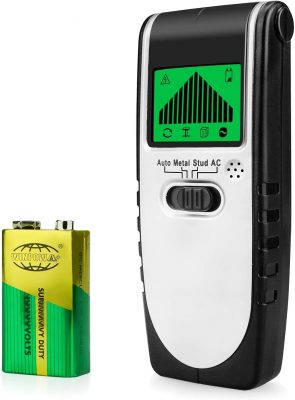
Editor’s Rating:
Design features
With a convenient design, the stud finder can easily be used for tasks around the house. For example, installing a wall mount for the TV can come with various issues. Residents may encounter live wires in the wall or other metals which may hinder their drill or even represent a safety risk. For this purpose, using the stud finder can be useful, even if just mounting a couple of shelves.
Its simple design is mainly based on the versatility of its 4 scan modes which are fairly represented on a small digital display. There is an indication bar on the screen for every stud. Its center point is represented by the highest bar. Its edges are represented by the shortest bars to the left and to the right. This is one of the simplest graphic stud representations seen on built-in displays.
Of course, the display also comes with extra pictograms to identify the scanning mode. This scanning mode can look for wires, metals, or even copper and aluminum at a depth of up to 1.18 inches. A beeping alert is also available with the stud finder. The tool only beeps on the center of the stud.
Convenient features
The stud finder is reliable. However, in order to get the best readings, it is recommended to take the process seriously. One common mistake is simply moving too fast. Users should take their time during the scan. Another mistake comes with wet walls where the paint is not dried. Gypsum surfaces are also known to create interferences for the best accuracy. Another top tip comes with uneven surfaces. Scanning these surfaces should be made behind cardboard.
Verdict
With an intuitive stud bar indicator, the scanner is even recommended for its short learning curve.
Pros
- Made with a unique stud bar indicator
- Detects metals down to 60mm
- Made to detect wood, aluminum, and copper
Cons
- Not best for freshly-painted walls
10. Aikotoo Magnetic Stud Finder
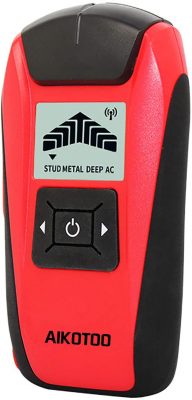
Editor’s Rating:
Design features
With one of the smallest designs in its class, an affordable stud finder is a worthy option in the box of tools of any home. It even comes with a digital display. While this display is not as complex as those seen on premium designs, it still does its job for the home or enthusiast user. Powered by a regular 9V battery, this stud finder can also be one of the energy-saving designs due to its simplified display.
Convenient features
Most importantly, the stud finder finds studs. General stud scans can be made at depths of up to 19 mm with 3mm error range. Deep scans go further up to 38mm with a 5mm error range. Metal scans work at depths of up to 28mm with 6mm error range. Finally, AC scans can go as far as 38mm.
Verdict
An affordable stud finder is a worthy option for small tasks around the home such as furniture installation.
Pros
- Compact size
- Automatic calibration
- Detects most studs
- Made from ABS plastic
Cons
- High error range for professionals
FAQ
I’ve never used a stud finder, can I scan for studs?
Never scanning for studs should not be a limiting factor. Most stud finders come with a short learning curve and they can be mastered within minutes.
Can I leave the battery inside my stud finder?
If the stud finder is used on a regular basis, the battery can remain inside. To prevent oxidation in the long term, it is recommended to remove the battery if the scanner is not used too often.
I’ve just painted over a wall but I can scan for studs, what can I do?
Those who have a freshly-painted wall might want to drill their holes back in position, which might be the case with bookshelves or TV stands. It is recommended to leave the wall dry completely before making a scan.
Do I need to scan each time I use the drill?
For safety purposes, a stud finder needs to be used before drilling. Unless the homeowner knows where the studs are, this is a must-do.
Guide to Buying the Best Stud Finder
Choosing the best stud finder is not complicated. There are not too many designs to consider which might make the entire process much shorter than expected. Here is what needs to be taken into consideration.
Digital display
A digital display is a norm for the best stud finders. It comes with all the essential information needed to find various studs. It even signals the edges of the studs for maximum precision. An added screen can also show the current scan mode.
Scan modes
Scan modes vary from general to specific AC wiring, wood or deep scanning. It is recommended to start scanning with the general mode which works with the best accuracy. Deep scanning might require going over a stud a few times.
Audible warnings
Audible warnings are not included in all stud finders. However, they can be a real aid when it comes to determining the exact center point of a stud. Users need to remember to mark this spot.
Calibration
Calibration is either user-defined or software-defined. Most stud finders come with user-defined calibration. Rarer products offer constant auto calibration functionality which might prove better for those making multiple readings per day even through plaster.
Ability to detect non-metals
Copper and aluminum are also seen inside walls. They might not be detected by the regular metal scanning mode of an electronic stud finder. At the same time, they can be real hazards when facing a drill. Copper pipes can be used for central heating and avoiding water damage is simply made by selecting the right stud finder and activating the right scanning mode.
Conclusion
Stud finders are used by professionals or by simple home residents. They are mostly reliable. But in order to get the most accurate results, the stud finders also need to be used correctly. Most problems occur with gypsum walls or with walls which have not completely dried after painting.
Uneven surfaces are another obstacle in the way of accurate results. Furthermore, it is important to know that some of the best stud finders on the market can overcome most of these problems if used correctly.
Since most stud finders come with user-based calibration, it is important to go through this process before every scan. For this reason, users can simply choose the right wall for calibration. The calibration process should not see the stud finder placed directly on top of a stud. The wall where calibration is being carried out should also be free from nails or other obstacles.
With proper calibration and reliable batteries, each stud finder is able to work with a high degree of accuracy. Most manufacturers also recommend slow movements during the scanning process. Without rushing every scan, slow movements can detect metals, wood, and AC wires up to a few inches deep. After a stud is discovered, a built-in marking tool or a pencil can be used to mark its position. Multiple scans can be made in the case of wires of piping to find the exact line they follow inside a wall.
